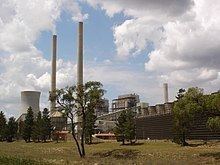Country Australia Opened 1957 Primary fuel Coal | Status Decommissioned Units operational 2 | |
 | ||
Make and model C. A. Parsons and Company Nameplate capacity 1,000 megawatts (1,300,000 hp) Commission date 1957 (A); 1961 (B); 1976 (C) Similar Blayney Wind Farm, Nymboida Power Station, Tallawarra Power Station, Liddell Power Station, Redbank Power Station | ||
Transformer been moved from wallerawang power station 2017
Wallerawang Power Station is a thermal coal power station, located near Wallerawang, in the Central Tablelands region of New South Wales, Australia. The power station is equipped with two turbo-alternators of 500 megawatts (670,000 hp) each, supplied by C. A. Parsons and Company of Newcastle-upon-Tyne, England. Due to dwindling demand, the first of the two generating units was mothballed in January 2013, and the second in April 2014.
Contents
Features and capacity
Wallerawang was originally built with four British Thompson Houston 30 megawatts (40,000 hp) single cylinder generators, completed in 1957-1959. Steam was supplied to each generator by a John Thompson 'Etaflow' boiler at a rate of 150,000 kilograms per hour (330,000 lb/h) at 600 pounds per square inch (4,100 kPa) and 540 °F (282 °C). This was referred to as Wallerawang A.
Wallerawang B consisted of two General Electric 60 megawatts (80,000 hp) 2–cylinder turbines with hydrogen cooled generators completed in 1961. Steam was supplied to each generator by a John Thompson boiler at a rate of 270,000 kilograms per hour (600,000 lb/h) at 900 pounds per square inch (6,200 kPa) and 900 °F (482 °C). Wallerawang A and B have both been decommissioned.
The two 500 megawatts (670,000 hp) units in the Wallerawang C station were completed in 1976 and 1980. Due to dwindling energy demand, in January 2013 the NSW government-owned corporation, Delta Electricity, mothballed one of the two remaining units of Wallerawang C for twelve months. The other was also mothballed 15 months later.
The coal for Wallerawang Power Station came from mines in the local area, delivered by private road. 75% of the coal comes from the Centennial Coal-owned Angus Place colliery.
Wallerawang Power Station drew its cooling water from Lake Wallace and Thompson's Creek dam, fresh water lakes on the Coxs River. Water from Lake Lyell and mine dewatering projects can also supply water in times of shortage. In 2007 and in 2009, water shortages occurred in the Fish River system, causing concern that the generating facility would be forced to close. Oberon Shire was also concerned about the level of potable water available from the Oberon Dam, a water cooling source for Wallerawang Power Station.
In July of 2013 EnergyAustralia acquired Wallerawang Power Station, along with Mount Piper Power Station, from Delta Electricity for a net cash consideration of A$160 million.
In November 2014 EnergyAustralia announced that it would permanently close Wallerawang due to ongoing reduced energy demand, lack of access to competitively priced coal and the power station’s high operating costs. EnergyAustralia began the process of removing useful equipment from the station in 2015 and begin demolition of the site when this process has been completed.
Pollutants
Carbon Monitoring for Action estimates that the Wallerawang Power Station emits approximately 6,500,000 tonnes (6,400,000 long tons) of CO2 each year as a result of burning coal. The Rudd government announced the introduction of a Carbon Pollution Reduction Scheme to help combat climate change that was expected to commence in 2010. However, a Bill to introduce the cap and trade system was defeated on the floor of the Parliament. The subsequent Australian Renewable Energy Agency Bill, 2011 (Cth) was enacted and established an emissions trading scheme to price carbon in Australia in a regulated manner between 2012 and June 2015. From July 2015, the price on carbon will be determined by market forces. The carbon pricing scheme was discontinued by the new Federal Government in 2014. It was expected that these measures would have impacted on emissions from power stations.
Wallerawang Power Station has emitted the following selected list of pollutants:
